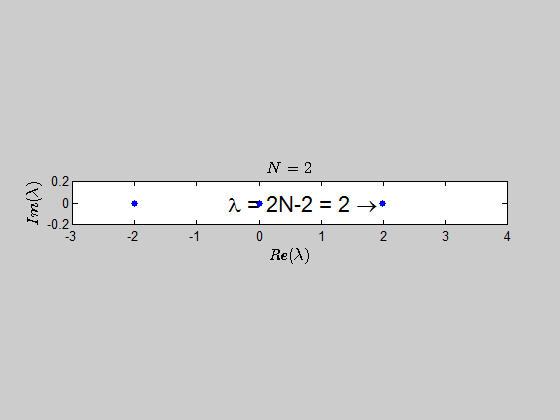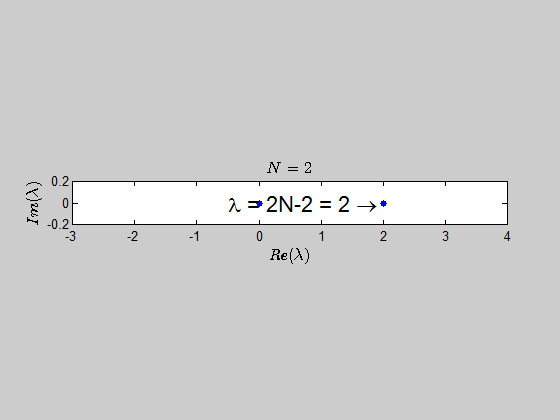I will answer your question just for the cases $N = 2$ and $N = 3$:
Let
$$ B_2 = \left(
\begin{array}{cccc}
0 & 1 & 1 & 0 \\
1 & 0 & 0 & 1 \\
1 & 0 & 0 & 1 \\
0 & 1 & 1 & 0
\end{array}
\right), \quad B_3 = \left(
\begin{array}{cccccc}
0 & 1 & 1 & 1 & 1 & 0 \\
1 & 0 & 1 & 1 & 0 & 1 \\
1 & 1 & 0 & 0 & 1 & 1 \\
1 & 1 & 0 & 0 & 1 & 1 \\
1 & 0 & 1 & 1 & 0 & 1 \\
0 & 1 & 1 & 1 & 1 & 0
\end{array}
\right), $$
then, $\text{Spec}{(B_2)} = {(-2,2,0,0)} \, $ and $\text{Spec}{(B_3)} = (-2,-2,0,0,0,4). $
With the help of numerics, I've been able to show (at least for sufficiently large values of $N$) that the characteristic polynomial is given by:
$$\color{blue}{p(\lambda) =\det{(B_N - \lambda I_{2N})} = (\lambda - 2N +2)(\lambda+2)^{N-1} \lambda^N }$$
which tells you that the only eigenvalues of this kind of matrices are $-2,0,2N-2 \ $ with the corresponding multiplicities given by $p(\lambda)$.
Here is an animation showing the spectrum of the matrices $B_N$ for $N \in (2,30)$:

Here's the same approach in the case we have the $B_N$ matrices defined as:
$$B_N = \begin{bmatrix} C_N & A_N \\ A_N & C_N \end{bmatrix},$$
then:
$$\color{blue}{p(\lambda) =\det{(B_N - \lambda I_{2N})} = \left\{ \begin{array}{ll}
\left(\lambda - 2N + 2\right) (\lambda-2)^{N/2}(\lambda+2)^{(N-2)/2} \lambda^{N} & N \text{ even} \\
\left(\lambda - 2N + 2\right) (\lambda-2)^{(N-1)/2}(\lambda+2)^{(N-1)/2} \lambda^{N} & N \text{ odd}
\end{array}\right.}$$
which tells you that the only eigenvalues of this kind of matrices are $-2,0,2,2N-2 \ $ with the corresponding multiplicities given by $p(\lambda)$.
Here is another animation showing the spectrum of the matrices $B_N$ for $N \in (2,30)$:

pretty cool!
Hope somebody can shed some light on these results.
Cheers!


Best Answer
Any matrix with diagonal blocks (assuming the blocks have the same size) can be converted to a block-diagonal matrix. In particular, suppose that $a_{ijk}$ denotes the $k$th diagonal entry of the block $A_{ij}$, so that $$ A_{ij} = \pmatrix{a_{ij1} \\ & \ddots \\ && a_{ijn}}. $$ There exists a permutation matrix $P$ such that $$ P^TAP = \pmatrix{B_1\\ & \ddots \\ && B_n}, $$ where $$ B_k = \pmatrix{ a_{11k} & \cdots & a_{1mk}\\ \vdots & \ddots & \vdots \\ a_{m1k} & \cdots & a_{mmk}}. $$
It follows that the inverse of $A$ (assuming it exists) satisfies $$ A^{-1} = P\pmatrix{B_1^{-1}\\ & \ddots \\ && B_n^{-1}}P^T. $$ In other words, $A^{-1}$ will have the block-structure $$ A^{-1} = \pmatrix{C_{11} & \cdots & C_{1m}\\ \vdots & \ddots & \vdots\\ C_{m1} & \cdots & C_{mm}}, $$ where $C_{ij}$ is a diagonal matrix whose $k$th diagonal entry is the $i,j$ entry of $B_k^{-1}$.
If you're interested in what the matrix $P$ looks like, it can be written as $$ P = \sum_{i,j = 1}^{m,n} (e_{i}^{(m)} \otimes e_j^{(n)})(e_j^{(n)} \otimes e_i^{(m)})^T $$ where $e_i^{(n)}$ denotes the $i$th canonical basis vector of $\Bbb R^n$ (the $i$th column of the size $n$ identity matrix), and $\otimes$ denotes the Kronecker product.